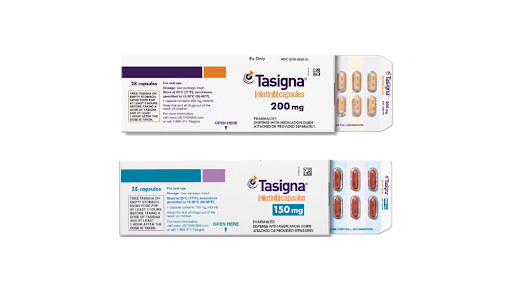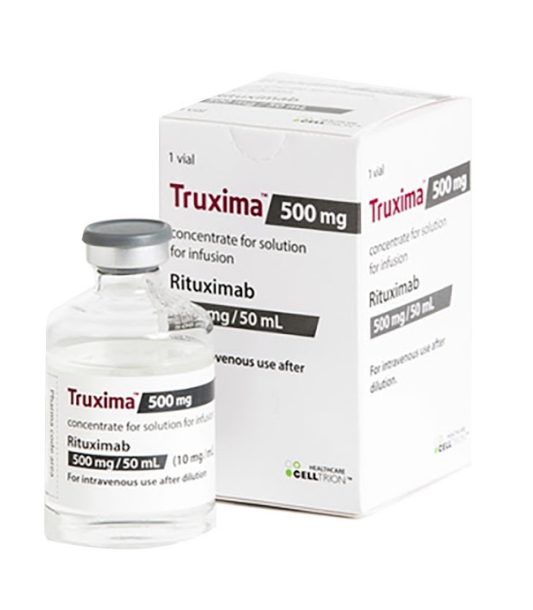Tasigna (nilotinib) vs Truxima (rituximab)
Tasigna (nilotinib) vs Truxima (rituximab)
Tasigna (nilotinib) is a tyrosine kinase inhibitor specifically used for the treatment of chronic myeloid leukemia (CML) with Philadelphia chromosome-positive (Ph+) status, targeting the abnormal BCR-ABL fusion protein that drives the disease. Truxima (rituximab), on the other hand, is a monoclonal antibody used to treat various types of blood cancers, including non-Hodgkin's lymphoma and chronic lymphocytic leukemia (CLL), as well as autoimmune diseases like rheumatoid arthritis, by targeting CD20 proteins on the surface of B cells. The choice between Tasigna and Truxima would depend on the specific type and characteristics of the cancer a patient has, as each medication is tailored to target different mechanisms involved in the proliferation of cancer cells.
Difference between Tasigna and Truxima
| Metric | Tasigna (nilotinib) | Truxima (rituximab) |
|---|---|---|
| Generic name | Nilotinib | Rituximab |
| Indications | Chronic myeloid leukemia (CML) | Non-Hodgkin's lymphoma, Chronic lymphocytic leukemia, Rheumatoid arthritis, Granulomatosis with polyangiitis, Microscopic polyangiitis |
| Mechanism of action | Tyrosine kinase inhibitor | Monoclonal antibody that targets CD20 antigen on B lymphocytes |
| Brand names | Tasigna | Truxima, Rituxan |
| Administrative route | Oral | Intravenous |
| Side effects | Rash, pruritus, nausea, fatigue, headache, constipation, diarrhea, vomiting | Infusion reactions, fever, lymphopenia, chills, infection |
| Contraindications | Long QT syndrome, hypokalemia, hypomagnesemia | Hepatitis B infection, severe infections, severe heart conditions |
| Drug class | Tyrosine kinase inhibitor | Monoclonal antibody |
| Manufacturer | Novartis | Celltrion Healthcare, Genentech (Rituxan) |
Efficacy
Tasigna (Nilotinib) Efficacy in Leukemia
Tasigna, known generically as nilotinib, is a targeted therapy used in the treatment of certain types of leukemia, specifically chronic myeloid leukemia (CML) in the chronic phase. Nilotinib is a tyrosine kinase inhibitor that specifically targets the BCR-ABL tyrosine kinase, an abnormal enzyme produced by leukemia cells in CML. The efficacy of Tasigna has been demonstrated in several clinical trials, where it has been shown to induce a high rate of hematologic and cytogenetic responses in patients with newly diagnosed CML. In these studies, nilotinib was effective in achieving complete cytogenetic response (CCyR) and major molecular response (MMR) in a significant proportion of patients.
Furthermore, long-term follow-up data suggest that Tasigna can provide sustained responses and has the potential to improve overall survival rates among CML patients. It is important to note that the response to nilotinib may vary based on the phase of CML and the presence of certain genetic mutations that can affect drug sensitivity. For optimal efficacy, adherence to the prescribed regimen and monitoring by a healthcare professional are crucial.
Truxima (Rituximab) Efficacy in Leukemia
Truxima, a biosimilar to the original rituximab, is a monoclonal antibody that targets the CD20 antigen found on the surface of B-cells. It is used in the treatment of various types of non-Hodgkin lymphoma, as well as chronic lymphocytic leukemia (CLL). In the context of CLL, rituximab has been shown to improve outcomes when used in combination with chemotherapy. The combination approach has been associated with prolonged progression-free survival and, in some cases, overall survival when compared to chemotherapy alone.
Clinical trials have established the efficacy of rituximab in the frontline and relapsed/refractory CLL settings. When combined with chemotherapy, rituximab enhances the cytotoxic effect, leading to increased rates of complete remission and partial remission in patients. It is important to note that while Truxima has been approved as a biosimilar, implying that it has no clinically meaningful differences from the reference product in terms of safety, purity, and potency, individual responses to treatment can still vary. As with all treatments, the use of Truxima should be guided by a healthcare professional, with consideration for the specific characteristics of the patient's disease.
Regulatory Agency Approvals
Tasigna
-
European Medical Agency (EMA), European Union

-
Food and Drug Administration (FDA), USA

-
Health Canada

-
Pharmaceuticals and Medical Devices Agency (PMDA), Japan

-
Therapeutic Goods Administration (TGA), Australia

-
Medsafe (NZ)

Truxima
-
European Medical Agency (EMA), European Union

-
Food and Drug Administration (FDA), USA

-
Health Canada

-
Therapeutic Goods Administration (TGA), Australia

-
Medsafe (NZ)

Access Tasigna or Truxima today
If Tasigna or Truxima are not approved or available in your country (e.g. due to supply issues), you can access them via Everyone.org.
How it works

Make an enquiry
Choose the medicine you want to buy, answer a couple of questions, and upload your prescription to speed things up. We’ll get back to you within 24 hours.


Make an enquiry
Choose the medicine you want to buy, answer a couple of questions, and upload your prescription to speed things up. We’ll get back to you within 24 hours.


Breeze through the paperwork
We'll guide you through the required documents for importing unapproved medicine, ensuring you have all the necessary information.


Get a personalized quote
We’ll prepare a quote for you, including medicine costs and any shipping, administrative, or import fees that may apply.


Receive your medicine
Accept the quote and we’ll handle the rest - sourcing and safely delivering your medicine.

Some text on this page has been automatically generated. Speak to your physician before you start a new treatment or medication.
Let's talk
If you have any questions, call us or send us a message through WhatsApp or email:
Contact us




